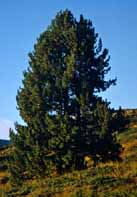Conservation Status

Pinus peuce
Grisebach 1846
Common names
Macedonian pine (Popnikola et al. 1978), Бяла мура, Молика [Bulgarian, Serbian], Βαλκανικό πεύκο [Greek], sosna Balkanskaya [Russian], Mazedonische kiefer [German], pin des Balcans [French], pino dei Balcani [Italian] (Jovanoviae 1986).
Taxonomic notes
Closely allied to the Himalayan P. wallichiana, but having shorter, stiffer leaves and shorter cones. For discussion of systematics relative to other species in subsection Strobus, see Phylogeny of East Asian white pines.
Claims that "Macedonian pine from Bulgaria is a separate variety vermiculata Christ, which differs from the western [Yugoslav] P. peuce with thinner and shorter needles, [and] shorter cones" (Cernjavski et al. 1959, cited in Popnikola et al. 1978) are not supported by observations. Bulgarian material shows the full range of measurements published for the western populations; variation of this sort was found to occur with increased altitude within Bulgaria, but not with geographical origin (Frankis 1998).
Description
Tree to 35-40 m tall, and 50-150 cm dbh. Bark on young trees smooth silvery grey, becoming darker and rough in middle age; very old trees with thick brown square-fissured bark. Branches level in lower crown, becoming erect in upper crown and at ends of branches; high altitude trees tend to have more erect branches than at lower altitudes. Shoots uninodal, green at first, grey-brown by end of first year, smooth, glabrous. Leaves 5 per fascicle, 4.5-10 cm long (not over 7 cm on treeline trees), slender, 0.7-0.8 mm thick, glossy green on outer face with white stomatal lines on inner faces, margins minutely serrulate; persistent 2-5 years; sheath 10-15 mm, deciduous by end of first autumn. Cones pendulous, (5-) 9-18 (-20) cm long (stunted, 5-13 cm, at treeline), cylindric, straight to slightly curved, green ripening orange-brown, scales adpressed to slightly incurved when cone closed (never reflexed at the cone base as in e.g. P. monticola); scales large, thin and fragile, apophysis smoothly rounded, 20 mm; umbo terminal, 2-3 mm, dark grey, unarmed. Cone peduncle 1 cm, grey, 6-8 mm thick. Seeds grey-brown, 7-8 mm with an adnate 14-22 mm wing; shed as soon as cones mature in October, 17-18 months after pollination. (Frankis 1998, additional data from Popnikola et al. 1978). See García Esteban et al. (2004) for a detailed characterization of the wood anatomy.
Distribution and Ecology
Endemic to the Balkan peninsula: Albania, Bulgaria, Montenegro, North Macedonia, and Greece; at 600-2200 m altitude (Popnikola et al. 1978, Jovanoviae 1986, Frankis 1998). Usually found on N slopes of on siliceous soils, rarely on carbonate soils (Jovanoviae 1986). Naturalised at Punkaharju, Finland (R.M. Lanner, cited in Jovanoviae 1986). Hardy to Zone 5 (cold hardiness limit between -28.8°C and -23.3°C) (Bannister and Neuner 2001).
Remarkable Specimens
Trees to 35 m, possibly 40 m tall, are frequent in the Rila and Pirin Mts, Bulgaria; a few very old trees have stem diameters over 150 cm (Frankis 1998). There is a report of a very large tree near the Rila Monastery, Bulgaria (Vladimir Dinets e-mail 1998.01.10).
The oldest known living specimen, 145 years, was documented in a tree-ring chronology covering the period 1837-1981 (crossdated after 1845), collected in Pelister National Park in North Macedonia by Fritz Schweingruber (doi.org/10.25921/53h0-5k67). Only one chronology has been developed for this species, and older trees likely exist.
Ethnobotany
Wood light, soft and durable. Used in building. Resin used in optical instruments industry (Jovanoviae 1986) (although not as widely used as resin from species of Abies). A valuable ornamental tree, very popular in Scandinavian parks and gardens, where it is known
as 'Silkefyr' ['Silk pine'] from its silky foliage. "At the Conifer Conference in 1972 it was described as 'undoubtedly the most useful five-needled pine for landscape planting'" (Johnson 1993). USDA hardiness zone 5.
Observations
The Rila and Pirin Mountains of Bulgaria are said to host some of the most extensive stands of this species.
Remarks
The epithet is from a Greek common name for pine trees.
At high altitudes (over 1800 m) multitrunk trees are frequent, to predominant at the 2200 m treeline, indicating seed dispersal by nutcrackers (Nucifraga caryocatactes), with trees germinating several together from unutilised seed caches (Frankis 1998). The Finnish naturalised trees were also dispersed by nutcrackers (R.M. Lanner in Richardson (1998)).
Very resistant to white pine blister rust, Cronartium ribicola.
This species is listed as "LR/nt" (lower risk, near threatened) by the WCMC (1998) database. Most or all in Bulgaria are now protected in National Parks. The only 'felled' trees seen on a visit in September 1998 were a few avalanche victims (Frankis 1998).
Citations
Frankis, M.P. Field notes and collections, Pirin & Rila Mts, Bulgaria, September 1998.
Grisebach, August Heinrich Rudolf. 1846. Spicilegium florae rumelicae et bithynicae exhibens synopsin plantarum Vol. 2. Brunsvigae Vieweg. p.349.
Johnson, Hugh. 1993. The International Book of Trees. London: Mitchell Beazley.
Jovanoviae, Branislav. 1986. "Pinus peuce," in Flora Srbije. Belgrade: Serbian Academy of Sciences and Arts.
Popnikola, N., M. Jovancevic, and M. Vidakovic. 1978. Genetics of Pinus peuce Gris. Annales Forestales 7/6: 187-206.
World Conservation Monitoring Centre - Trees [WCMC]. 1998. Database at http://www.wcmc.org.uk/cgi-bin/SaCGI.cgi/trees.exe, accessed 1998.10.01, now defunct.
Thanks to Milan Jovanovic for information and assistance contributed 1999.02.
See also
Elwes and Henry 1906-1913 at the Biodiversity Heritage Library (as P. peuke). This series of volumes, privately printed, provides some of the most engaging descriptions of conifers ever published. Although they only treat species cultivated in the U.K. and Ireland, and the taxonomy is a bit dated, still these accounts are thorough, treating such topics as species description, range, varieties, exceptionally old or tall specimens, remarkable trees, and cultivation. Despite being over a century old, they are generally accurate, and are illustrated with some remarkable photographs and lithographs.


